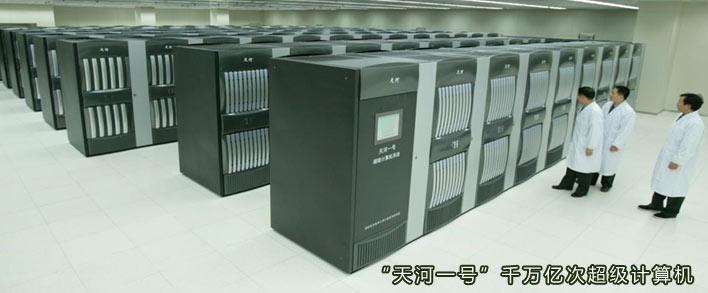 China’s National Supercomputer Centre announced that the prototype for its exascale supercomputer will be completed later this year, ahead of its initial date in 2018. The successful performance and commercialization of the computer is presumed to drastically improve existing 3D printing or additive manufacturing methods.
China’s National Supercomputer Centre announced that the prototype for its exascale supercomputer will be completed later this year, ahead of its initial date in 2018. The successful performance and commercialization of the computer is presumed to drastically improve existing 3D printing or additive manufacturing methods.
Over the past few years, the Chinese government and companies in the private sector have been increasingly focused on the development of supercomputers. The Tianhe supercomputer series which feature Tianhe-1 and Tianhe-2, still remains as the most powerful supercomputer series, below the Sunway TaihuLight which was released in mid-2016.
Zhang Ting, a computer engineer based in the National Supercomputing Center of Tianjin located at the National Defense Science and Technology University, revealed earlier this month that in 2020, three years after the completion of the prototype, the exascale computer will be used to its full potential, running a wide range of applications, networks and platforms.
“A complete computing system of the exascale supercomputer and its applications can only be expected in 2020, and will be 200 times more powerful than the country’s first petaflop computer Tianhe-1, recognized as the world’s fastest in 2010,” said Ting.
Still, the general population including technology communities struggle to understand the potential the exascale computing project holds. More importantly, the impact of the launch of an exascale computer on the global technology ecosystem and data-based operations.
Exascale computing is based on a rate of 1,000,000,000,000,000,000 calculations / second – or a quintillion (a billion billion) calculations per second. An exascale computer’s rapid rate of data processing is presumed to optimize any operations or initiatives which include analysis or evaluation of massive volumes of information. Technologies like artificial intelligence (AI) or 3D printing that consider an immense amount of data points can be optimized with exascale computing.
In fact, the developers of the exascale computer specifically emphasized its capability of simulating and operating additive manufacturing processes. The Exascale Computing Project (ECP) development team stated:
“At a quintillion calculations each second, exascale supercomputers will more realistically simulate the processes involved in precision medicine, regional climate, additive manufacturing, the conversion of plants to biofuels, the relationship between energy and water use, the unseen physics in materials discovery and design, the fundamental forces of the universe, and much more.”
Speeds or efficiency of 3D printing or additive manufacturing methods mostly rely on hardware such as 3D printers. 3D scanners, and imaging and editing technologies can improve the designing and prototyping processes but the performance of a computer hardly affects the final phase of additive manufacturing.
However, phases of designing, development and prototyping have proven to be most time consuming and labor heavy for manufacturers because of the accuracy and precision required to produce error-free end products.
Through the usage of an exascale computing-based application, manufacturers will be able to use additive manufacturing technologies to better simulate end products and significantly optimize processes before the last stage of manufacturing.
Stephen Lee, ECP Deputy Director, firmly believes the exascale computer will unlock opportunities for emerging technologies like 3D printing technology to enter a new era of computing and high-performance.
“Computational power is a vitally important tool that enables scientific discovery and assists us in finding solutions to some of our most difficult problems. The quest to achieve capable exascale computing is a quintessential technological challenge that will serve to enable a new generation of insights into such discoveries and solutions,” said Lee.
Discuss in the Exascale Supercomputer forum at 3DPB.com.
[Image Sources: People’s Daily, NDSTU]
Subscribe to Our Email Newsletter
Stay up-to-date on all the latest news from the 3D printing industry and receive information and offers from third party vendors.
You May Also Like
Gorilla Sports GE’s First 3D Printed Titanium Cast
How do you help a gorilla with a broken arm? Sounds like the start of a bad joke a zookeeper might tell, but it’s an actual dilemma recently faced by...
Nylon 3D Printed Parts Made More Functional with Coatings & Colors
Parts 3D printed from polyamide (PA, Nylon) 12 using powder bed fusion (PBF) are a mainstay in the additive manufacturing (AM) industry. While post-finishing processes have improved the porosity of...
$25M to Back Sintavia’s Largest Expansion of Metal 3D Printing Capacity Since 2019
Sintavia, the digital manufacturing company specializing in mission-critical parts for strategic sectors, announced a $25 million investment to increase its production capacity, the largest expansion to its operations since 2019....
Velo3D Initiates Public Offering in a Bid to Strengthen Financial Foundations and Drive Future Growth
Velo3D (NYSE: VLD) has been among a number of publicly traded 3D printing firms that have attempted to weather the current macroeconomic climate. After posting a challenging financial report for 2023,...

































